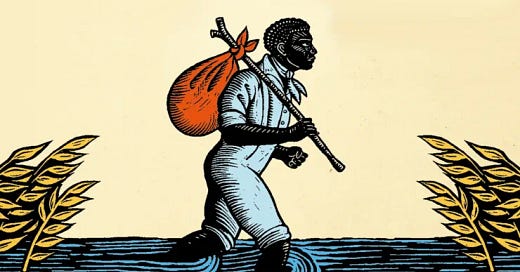Huck Finn: Chapters 1-7
"Persons attempting to find a motive in this narrative will be prosecuted"
Hello, readers!
I’m so glad you’re here as we start in on Mark Twain’s all-time American classic, The Adventures of Huckleberry Finn. I read this book in high school and didn’t love it (which was the case for most of the assigned reading of my teenage years) — and, frankly, I’ve kinda written it off since then.
Jumping back into it this week has been a bit of a revelation. I love the interplay between simple boyhood adventure and complex coming-of-age story, I think the writing style and language are brilliant, and Twain’s subtle critiques of the adult world are just as biting today as they were back then. I’m thoroughly enjoying it so far.
In this week’s recap let’s talk through the big themes of the first seven chapters and touch on what remains the most controversial aspect of this novel: Twain’s use of the n-word.
Let’s Talk (Briefly) About the N-Word
A number of you have already mentioned how galling the use of the n-word is in this story. It really stops you in your tracks when you first encounter it. As we read Huck Finn, it’s worth remembering a few things about its use in this story.
1) Twain grew up in Missouri in the mid-1800s, which was a firmly a pro-slavery area. There was a bit of an abolitionist movement in Missouri, but it was by far the minority. Twain carried the beliefs of his parents and region into young adulthood (not in any kind of virulent, violent way), but then genuinely changed his ways and came to advocate for abolition. Just as he skewered hypocrisy in religion and business, he recognized the discord between espousing the ideas of freedom and slavery at the same time.
2) In that era, the n-word was indeed still used as a derogatory term towards Black folks. It was widely used by the white community in their everyday communications with each other and with the Black community. It was considered “coarse” and unsuitable for children, which led to Huck Finn facing criticism from the moment it was published. That said, it wasn’t viewed with the same level of derision, on a societal level, as it is today. Nowadays, it’s obviously and rightly completely unacceptable. Within Huck Finn, however, it can’t be fully removed from the context of the time.
3) Taken together, modern readers can then safely approach the text with an understanding that Twain was purposefully using the word, and using it heavily, to make a point. He wanted readers to be slapped in the face and to have to confront their own uncomfortable feelings. Readers in the 19th century would disparage the word in print but then go and use it themselves. For Twain, using the word was a harsh critique, not a racist epithet.
Today, most scholars agree that while it’s uncomfortable, it’s a necessary discomfort. I’ll end this section with a quote from a paper that I found rather insightful:
“Twain's repeated use of the racial slur is not gratuitous but serves to expose the pervasive racism of the era, forcing readers to confront uncomfortable truths about America's past.”
More Than Just a Boy’s Adventures
Keep reading with a 7-day free trial
Subscribe to The Big Read to keep reading this post and get 7 days of free access to the full post archives.




